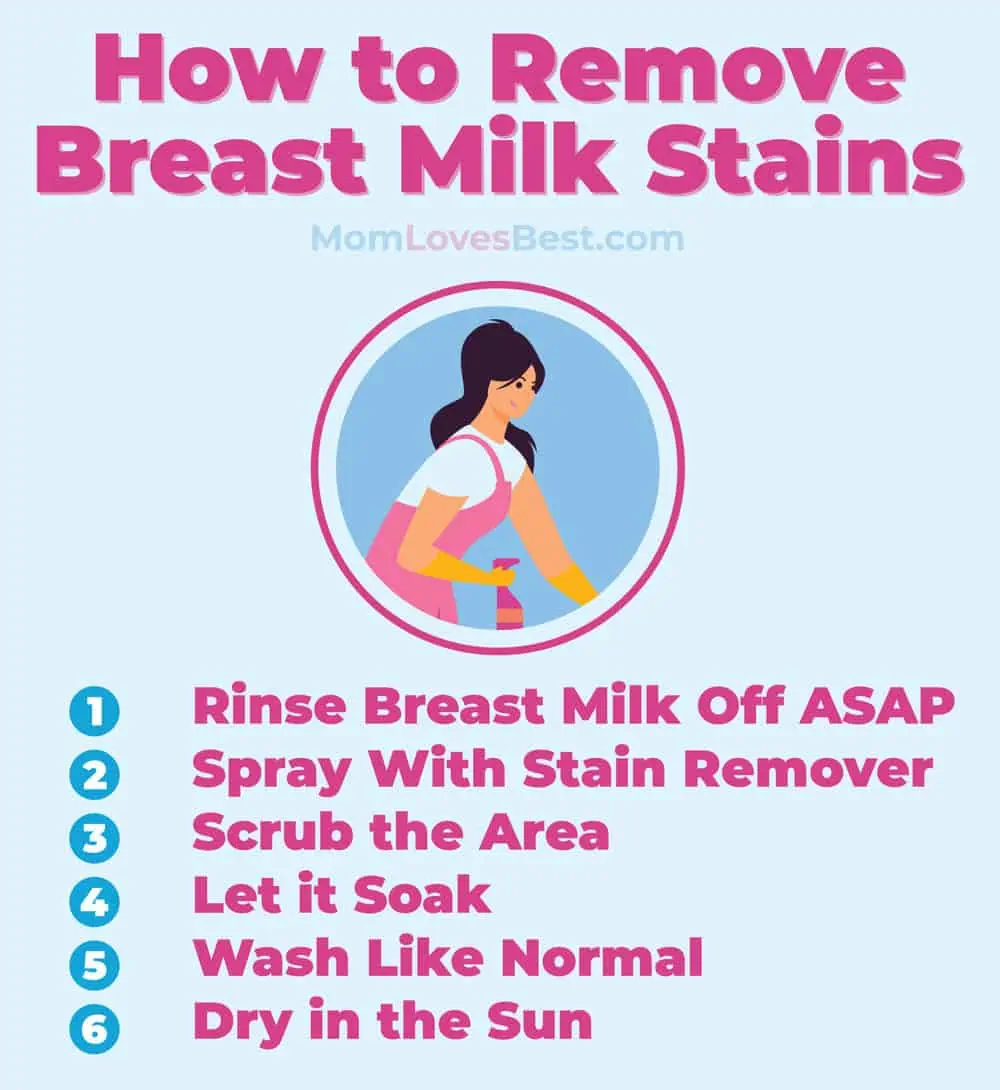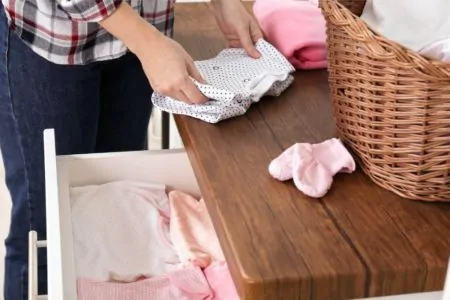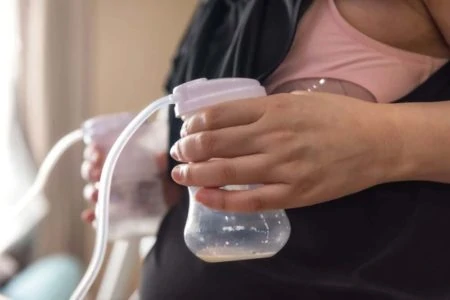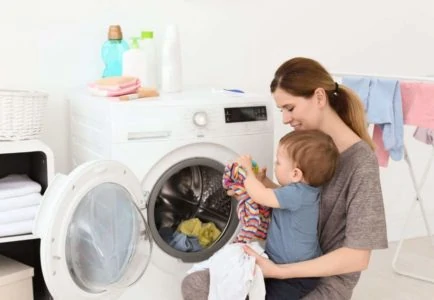Breast milk stains are notorious for appearing days, weeks, or even months after the laundry is done. They are protein-based, meaning they require specific treatment to break down.
Don’t panic and toss those clothes just yet. We have dealt with the leaky faucet phase and learned exactly how to salvage fabrics. Here is the science behind the stain, the best products to use, and a six-step guide to removing breast milk stains for good.
Key Takeaways
- Act fast: Fresh stains are easier to remove, so rinse milk spills immediately with cold water.
- Use enzymes: You need a detergent or treatment containing enzymes (specifically protease) to digest the milk proteins.
- Skip the heat: Hot water and dryer heat will cook the protein, setting the stain permanently into the fibers.
- Harness the sun: UV rays act as a natural bleaching agent to fade lingering yellow discoloration.
Why Does Breast Milk Leave Such Prominent Stains?
Breast milk is complex; it contains fats, proteins, and sugars essential for your baby. While the fat can cause grease spots, the real culprit behind that stubborn discoloration is the protein.
Similar to blood or egg stains, breast milk is a protein-based stain. When these proteins dry, they bind tightly to fabric fibers. If they aren’t washed out completely, they oxidize over time.
This oxidation is why you might put a perfectly clean white onesie into a storage bin and pull it out six months later covered in yellow splotches. To fix this, you need to break the chemical bond using enzymes and cool water (1).
Remember
Which Cleaning Products are Safe to Use?
The laundry aisle is overwhelming, but you only need to look for one key keyword: **Enzymes**.
Whether you choose a plant-based formula or a heavy-duty chemical cleaner, the product must contain enzymes to eat away the organic proteins in the milk. Without them, you are just washing the surface (2).
However, you also need to consider your baby’s skin. Newborns are sensitive to harsh fragrances and surfactants. Look for “Free and Clear” options or products specifically dermatologically tested for sensitive skin when treating baby clothes.
Caution
Can I Use Bleach?
It depends on the type of bleach.
Chlorine Bleach: Avoid this. It is harsh, fumes can irritate your baby’s respiratory system, and it can actually yellow protein stains further rather than whitening them (3).
Oxygen Bleach: This is generally safe and effective. Oxygen bleach (often found in powders like OxiClean) uses sodium percarbonate to lift stains without the harsh toxicity of chlorine. It is a great option for soaking dingy whites or old set-in stains.
How Can I Avoid Breast Milk Stains?
Prevention is easier than the cure. Try these habits to minimize laundry disasters:
- Rinse immediately: Even if you can’t wash it right away, run the spot under cold water to dilute the proteins.
- Layer up: Use absorbent nursing pads inside your bra to catch leaks.
- Protect your gear: Keep a designated “messy” towel or blanket over your nursing pillow during feeds.
- Proper storage: Do not store clothes in airtight plastic bags; lack of airflow can accelerate yellowing. Use cotton bags or acid-free tissue paper.
Six Simple Steps to Remove Breast Milk Stains From Clothing
Ready to tackle the laundry pile? We have broken this down into a foolproof method that works on fresh spills and old, mystery yellow spots alike.
1. Rinse With Cold Water.
Time is of the essence. As soon as you notice a spill, run the fabric under cold water. Do not use warm or hot water, as heat causes the proteins to bind to the fibers. If the stain has dried, soak the item in a basin of cold water for 30 minutes to loosen the bond.
2. Apply a Pre-Treatment.
Once the fabric is wet, you need to apply a concentrated cleaner directly to the spot. Agitation is key here, so gently rub the fabric together or use a soft brush.
Natural Stain Removers
If you prefer plant-based ingredients to protect your baby’s sensitive skin, these products are effective against organic proteins:
- Buncha Farmers Stain Stick: This stick uses coconut oil and borax to lift grime. It lasts a long time and is perfect for travel; just wet the stick and rub it on.
- Lemon Juice: The acetic acid in lemon juice acts as a mild bleaching agent. Squeeze it onto white fabrics and let them sit in the sun for a double-whammy of whitening power.
- Hydrogen Peroxide: A 3% solution works wonders on organic stains. It degrades into water and oxygen, making it environmentally safe. Test for colorfastness on colored clothes first.
Synthetic Stain Removers
For heavy-duty messes or set-in stains, synthetic formulas often contain more potent enzymes and surfactants to cut through the fat and protein:
- Fels Naptha Laundry Bar: This old-school laundry bar is a budget-friendly powerhouse. Wet the bar and rub it vigorously into the stain before washing. It is excellent for oil-based residues.
- Medela Soap: While designed for pump parts, this soap is specifically formulated to break down breast milk fat and protein, making it a secret weapon for spot-cleaning nursing clothes.
- Biz: This is an enzyme-based detergent booster. It is highly effective for soaking clothes that have “mystery yellow stains” pulled from storage.
- OxiClean Baby Stain Remover: This version is free from dyes and perfumes but still uses oxygen power to lift stains. It is a staple in many laundry rooms for a reason.
- Dawn Dish Soap: The blue stuff is legendary for removing grease. Since breast milk has a high fat content, a drop of Dawn can help lift oily residues that other detergents miss.
3. Scrub Gently.
Use an old toothbrush or a soft laundry brush to work the stain remover into the fibers. This mechanical action helps lift the proteins physically. Be gentle with delicate knits to avoid pilling.
4. Let it Soak.
Patience is your friend. Let the pre-treatment sit for at least 15 to 30 minutes. For older, set-in yellow stains, you may need to soak the garment in a mixture of water and oxygen bleach (like OxiClean or Biz) overnight.
5. Wash on Cold or Warm.
Launder the item as usual using a high-quality baby detergent. Check the care label; use the warmest water allowed for the fabric only if you are sure the stain is mostly gone. If you are unsure, stick to cold water to be safe.
6. Sun Dry.
Skip the dryer. High heat will lock in any remaining residue. Instead, hang the wet item in direct sunlight. UV rays are a powerful natural bleaching agent that can fade remaining yellow pigments significantly. Once the item is dry and you confirm the stain is gone, you can tumble dry it next time.
FAQs
Bye-Bye, Yellow Spots
Dealing with laundry is endless when you have a baby, but those yellow stains don’t have to be a permanent part of your wardrobe. The winning combination is simple: act fast, use cold water, and let enzymes do the heavy lifting.
Don’t toss those cute hand-me-downs just yet. With a little soak and some sunshine, you can get those onesies sparkling clean again.









